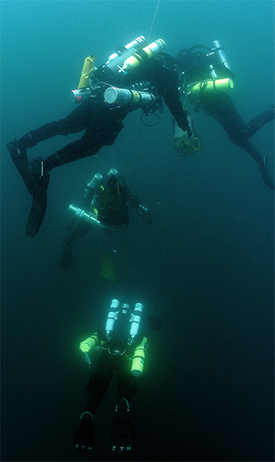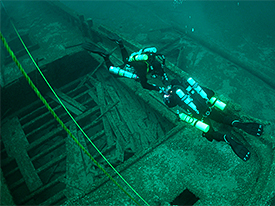
Closed Circuit Rebreathers:
Training for the Walter B. Allen
31 August 2010
By Matt Carter

All divers on the project used closed circuit rebreathers (photograph courtesy of Tamara Thomsen).
Initially I visited the Wisconsin Historical Society - Maritime Preservation and Archaeology Program in October 2009 as part of my Rolex Our World Underwater Scholarship. I worked with the archaeologists there for three weeks, assisting in their day to day operation. During that time I began taking classes in technical diving, and was introduced to closed circuit rebreathers. I left still uncertain how useful the classes would be for me in my future pursuits...
In 2006, when the Society surveyed the schooner Rouse Simmons in 155 ft of water, half of the survey crew dived closed circuit rebreathers, and the other half dived open circuit. From a comparative cost analysis of the project expenses, it was determined that for the additional cost paid out for the gases needed to supply an open circuit diver for the project, that money was substantial enough to fund training for the volunteer diver to learn a closed circuit rebreather for use on future projects. For the next several years, the Society converted their volunteer divers over to closed circuit rebreather divers. The divers purchased their choice of rebreather models, but the training on the units was paid out by the Society and the overall cost of project expenses continued to decline. The Walter B. Allen survey is the first survey the Society conducted exclusively on closed circuit rebreathers with seven divers using three different models of rebreathers, O2ptima, KISS Classic and Megalodon over the duration of the project.

Two divers using trimix gases for longer dive times at great depth. Note the array of tanks required. Large View (photograph courtesy of Tamara Thomsen).
When I arrived in Wisconsin in June, it was boots on the ground running. I spent 12 hours in water over my first week in the country training on a KISS Classic manual rebreather. This rebreather was given to me on loan for the duration of my internship. Above the initial 12 hours of training on the unit, I, along with several of the other volunteers, needed to accumulate an additional 50 hours of dive time to qualify for the next step in training - the use of trimix. It took about a monthís time of diving fanatically to achieve this goal. To participate on the Walter B. Allen survey, we were required to complete the Trimix CCR certification which is an additional 8 hours of in water time on the unit to depths of 200ft.

Divers exploring the canaller Walter B. Allen. Large View (Photograph courtesy of Tamara Thomsen).
Feeling well prepared and having over 70 hours underwater on a number of the State of Wisconsinís fantastic shipwrecks - all seen over the loop of my KISS Classic CCR - the next challenge was to work, study and survey a shipwreck underwater, while using the unit. Piece of cake - itís all about the training!
Return to MUA Project Journals home page.

